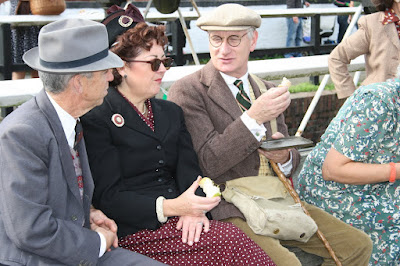Last week I went to Langar in Nottinghamshire for a meeting of my professional institution. Arriving a little early at the venue I decided to drive on a short distance to investigate the lovely rolling countryside. Just two miles south along the road from Langar I came into Leicestershire and the village of Harby. At the entrance to the village I crossed a bridge which had the unmistakable signs of belonging to British Waterways - barriers painted in black and white. Looking down there was water in the canal and across the bridge there was a BW maintenance yard to confirm that I had indeed discovered a canal- the Grantham Canal.

BW Maintenance Yard, Harby, Leicestershire
If I had been a bit smarter I should have realised that the Grantham Canal must have been close because near Langar I came through the roadworks on the A46 where a new road was being built. Granny Buttons has posted quite a few blogs relating the difficulties that the Grantham Canal Society and others are having with the Highways Agency in their efforts to preserve the canal line from the new road developments. It appears from Narrowboat World that their efforts regarding Manns Bridge may have failed.

The Grantham Canal is not fully navigable, of course, but large sections are in water and it appears that the canal society do have a day boat operating along one section near Grantham. I decided I had enough time before my meeting to walk along the towpath towards Hose. This section is in water. I didn't manage to go far, but my short time by the canal convinced me that it is a delightful waterway. The first section of canal was fringed by large bulrushes (just like the BW logo) but the canal soon opened out into a clear section with the usual ducks and moorhens and a family of swans. The views from the canal across the Vale of Belvoir to the north are impressive. The canal is elevated at this point. If opened to navigation I am sure that this would be a popular cruising canal.
I walked about 3/4 mile and passed several walkers with and without dogs. I have to mention that the condition of the path was far better than many I have encountered when boating. During a wet period in autumn it was walkable in ordinary shoes - I was in a business suit!. A bit different walking along the Oxford Canal where you are often in danger of slipping in. The last time we boated along the South Oxford we witnessed a cyclist going into the canal in dramatic way. He was carrying camping equipment and it went in with him!


Bridge 42
As I stood by the bridge at Harby (Langar Bridge) I noted that it had a BW number (43) but at my feet I noticed that the coping stone on the edge of the canal had an inscription, presumably original, "Miles from the Trent". I couldn't discern how many miles it claimed, that was missing or it was underneath grass, but a handy modern marker near the hedge gave the figure as 18. So Harby is just about half-way along the length of the canal.

Milestone at Harby

Metal Milepost at Harby

Interpretation board near Bridge 41
I am tempted to try a "proper" walk along the canal. The Vale of Belvoir has a lot to offer.













